Failure Mode and Effects Analysis in Saudi Arabia Healthcare
VerifiedAdded on 2022/11/09
|10
|2941
|316
Report
AI Summary
This report delves into the concept of Failure Mode and Effects Analysis (FMEA), a systematic approach used to identify and prevent potential failures in products and processes, particularly within competitive industries like healthcare. The report emphasizes FMEA's significance in quality improvement, risk management, and customer satisfaction. It explores the background of FMEA, highlighting its importance in product design and its application in healthcare, especially in countries like Saudi Arabia. The study aims to discuss FMEA in general, focusing on its applications, significance, and implementation in the Saudi Arabian healthcare sector. The methodology involves a literature review, using specific inclusion and exclusion criteria to gather relevant articles. The report concludes that FMEA is fundamental in improving quality and efficiency in healthcare, with its implementation in the Saudi Arabian health sector potentially leading to enhanced service delivery and improved patient outcomes. The report also references various studies and researchers who have contributed to the understanding and application of FMEA in healthcare settings.

Running Head: FMEA 1
Failure Mode and Effects Analysis (FMEA)
Name
Institution
Date
Failure Mode and Effects Analysis (FMEA)
Name
Institution
Date
Paraphrase This Document
Need a fresh take? Get an instant paraphrase of this document with our AI Paraphraser
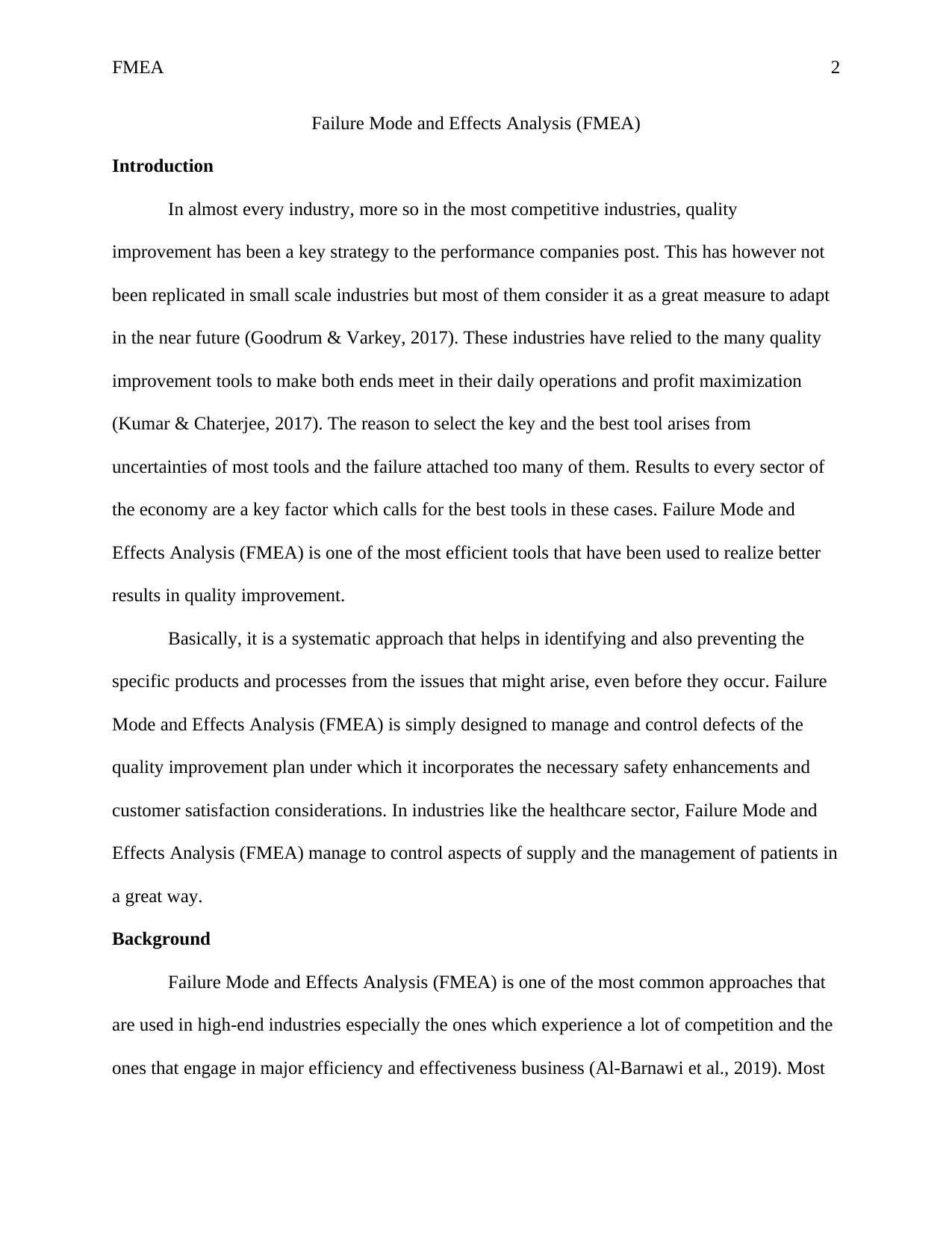
FMEA 2
Failure Mode and Effects Analysis (FMEA)
Introduction
In almost every industry, more so in the most competitive industries, quality
improvement has been a key strategy to the performance companies post. This has however not
been replicated in small scale industries but most of them consider it as a great measure to adapt
in the near future (Goodrum & Varkey, 2017). These industries have relied to the many quality
improvement tools to make both ends meet in their daily operations and profit maximization
(Kumar & Chaterjee, 2017). The reason to select the key and the best tool arises from
uncertainties of most tools and the failure attached too many of them. Results to every sector of
the economy are a key factor which calls for the best tools in these cases. Failure Mode and
Effects Analysis (FMEA) is one of the most efficient tools that have been used to realize better
results in quality improvement.
Basically, it is a systematic approach that helps in identifying and also preventing the
specific products and processes from the issues that might arise, even before they occur. Failure
Mode and Effects Analysis (FMEA) is simply designed to manage and control defects of the
quality improvement plan under which it incorporates the necessary safety enhancements and
customer satisfaction considerations. In industries like the healthcare sector, Failure Mode and
Effects Analysis (FMEA) manage to control aspects of supply and the management of patients in
a great way.
Background
Failure Mode and Effects Analysis (FMEA) is one of the most common approaches that
are used in high-end industries especially the ones which experience a lot of competition and the
ones that engage in major efficiency and effectiveness business (Al-Barnawi et al., 2019). Most
Failure Mode and Effects Analysis (FMEA)
Introduction
In almost every industry, more so in the most competitive industries, quality
improvement has been a key strategy to the performance companies post. This has however not
been replicated in small scale industries but most of them consider it as a great measure to adapt
in the near future (Goodrum & Varkey, 2017). These industries have relied to the many quality
improvement tools to make both ends meet in their daily operations and profit maximization
(Kumar & Chaterjee, 2017). The reason to select the key and the best tool arises from
uncertainties of most tools and the failure attached too many of them. Results to every sector of
the economy are a key factor which calls for the best tools in these cases. Failure Mode and
Effects Analysis (FMEA) is one of the most efficient tools that have been used to realize better
results in quality improvement.
Basically, it is a systematic approach that helps in identifying and also preventing the
specific products and processes from the issues that might arise, even before they occur. Failure
Mode and Effects Analysis (FMEA) is simply designed to manage and control defects of the
quality improvement plan under which it incorporates the necessary safety enhancements and
customer satisfaction considerations. In industries like the healthcare sector, Failure Mode and
Effects Analysis (FMEA) manage to control aspects of supply and the management of patients in
a great way.
Background
Failure Mode and Effects Analysis (FMEA) is one of the most common approaches that
are used in high-end industries especially the ones which experience a lot of competition and the
ones that engage in major efficiency and effectiveness business (Al-Barnawi et al., 2019). Most
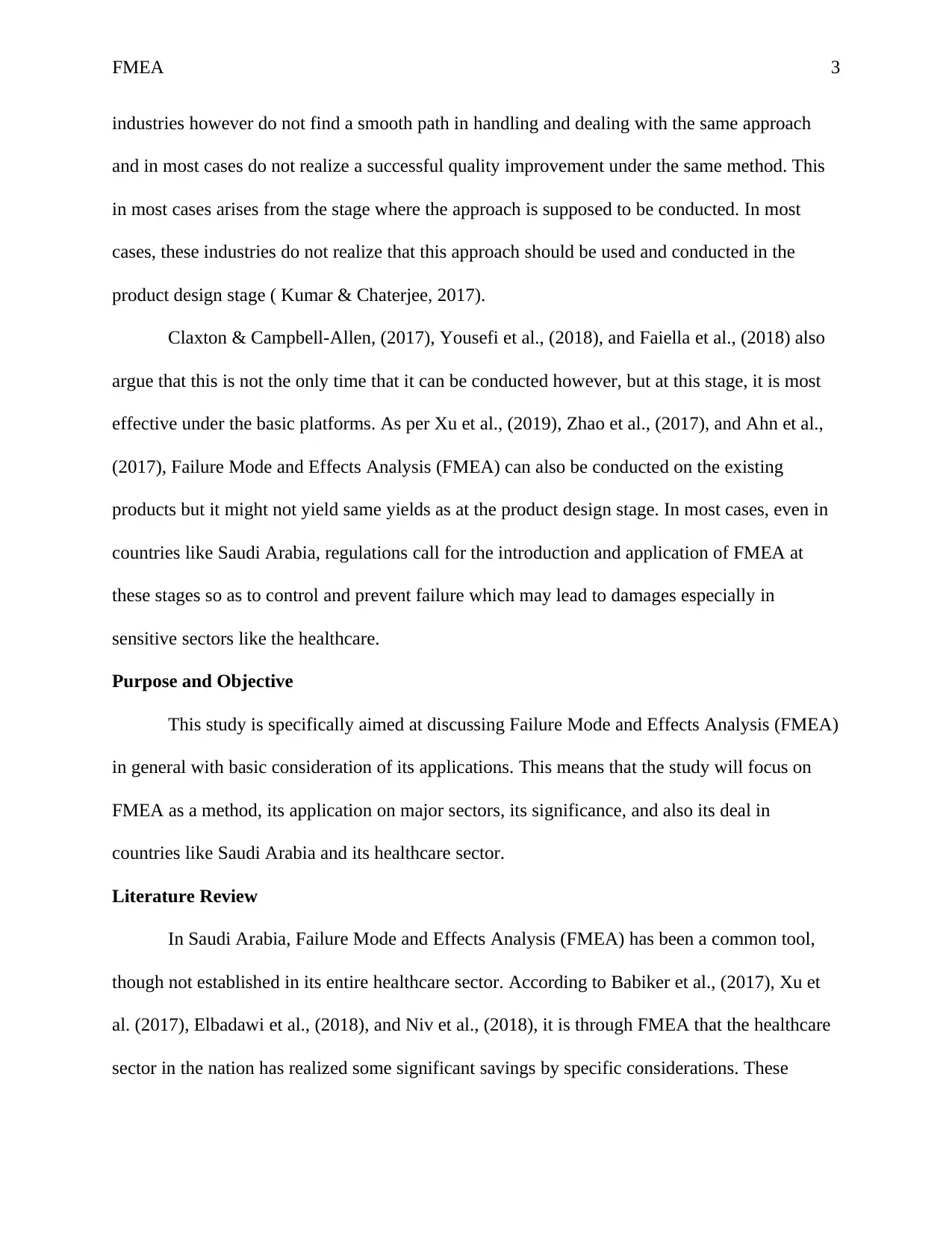
FMEA 3
industries however do not find a smooth path in handling and dealing with the same approach
and in most cases do not realize a successful quality improvement under the same method. This
in most cases arises from the stage where the approach is supposed to be conducted. In most
cases, these industries do not realize that this approach should be used and conducted in the
product design stage ( Kumar & Chaterjee, 2017).
Claxton & Campbell-Allen, (2017), Yousefi et al., (2018), and Faiella et al., (2018) also
argue that this is not the only time that it can be conducted however, but at this stage, it is most
effective under the basic platforms. As per Xu et al., (2019), Zhao et al., (2017), and Ahn et al.,
(2017), Failure Mode and Effects Analysis (FMEA) can also be conducted on the existing
products but it might not yield same yields as at the product design stage. In most cases, even in
countries like Saudi Arabia, regulations call for the introduction and application of FMEA at
these stages so as to control and prevent failure which may lead to damages especially in
sensitive sectors like the healthcare.
Purpose and Objective
This study is specifically aimed at discussing Failure Mode and Effects Analysis (FMEA)
in general with basic consideration of its applications. This means that the study will focus on
FMEA as a method, its application on major sectors, its significance, and also its deal in
countries like Saudi Arabia and its healthcare sector.
Literature Review
In Saudi Arabia, Failure Mode and Effects Analysis (FMEA) has been a common tool,
though not established in its entire healthcare sector. According to Babiker et al., (2017), Xu et
al. (2017), Elbadawi et al., (2018), and Niv et al., (2018), it is through FMEA that the healthcare
sector in the nation has realized some significant savings by specific considerations. These
industries however do not find a smooth path in handling and dealing with the same approach
and in most cases do not realize a successful quality improvement under the same method. This
in most cases arises from the stage where the approach is supposed to be conducted. In most
cases, these industries do not realize that this approach should be used and conducted in the
product design stage ( Kumar & Chaterjee, 2017).
Claxton & Campbell-Allen, (2017), Yousefi et al., (2018), and Faiella et al., (2018) also
argue that this is not the only time that it can be conducted however, but at this stage, it is most
effective under the basic platforms. As per Xu et al., (2019), Zhao et al., (2017), and Ahn et al.,
(2017), Failure Mode and Effects Analysis (FMEA) can also be conducted on the existing
products but it might not yield same yields as at the product design stage. In most cases, even in
countries like Saudi Arabia, regulations call for the introduction and application of FMEA at
these stages so as to control and prevent failure which may lead to damages especially in
sensitive sectors like the healthcare.
Purpose and Objective
This study is specifically aimed at discussing Failure Mode and Effects Analysis (FMEA)
in general with basic consideration of its applications. This means that the study will focus on
FMEA as a method, its application on major sectors, its significance, and also its deal in
countries like Saudi Arabia and its healthcare sector.
Literature Review
In Saudi Arabia, Failure Mode and Effects Analysis (FMEA) has been a common tool,
though not established in its entire healthcare sector. According to Babiker et al., (2017), Xu et
al. (2017), Elbadawi et al., (2018), and Niv et al., (2018), it is through FMEA that the healthcare
sector in the nation has realized some significant savings by specific considerations. These
⊘ This is a preview!⊘
Do you want full access?
Subscribe today to unlock all pages.

Trusted by 1+ million students worldwide
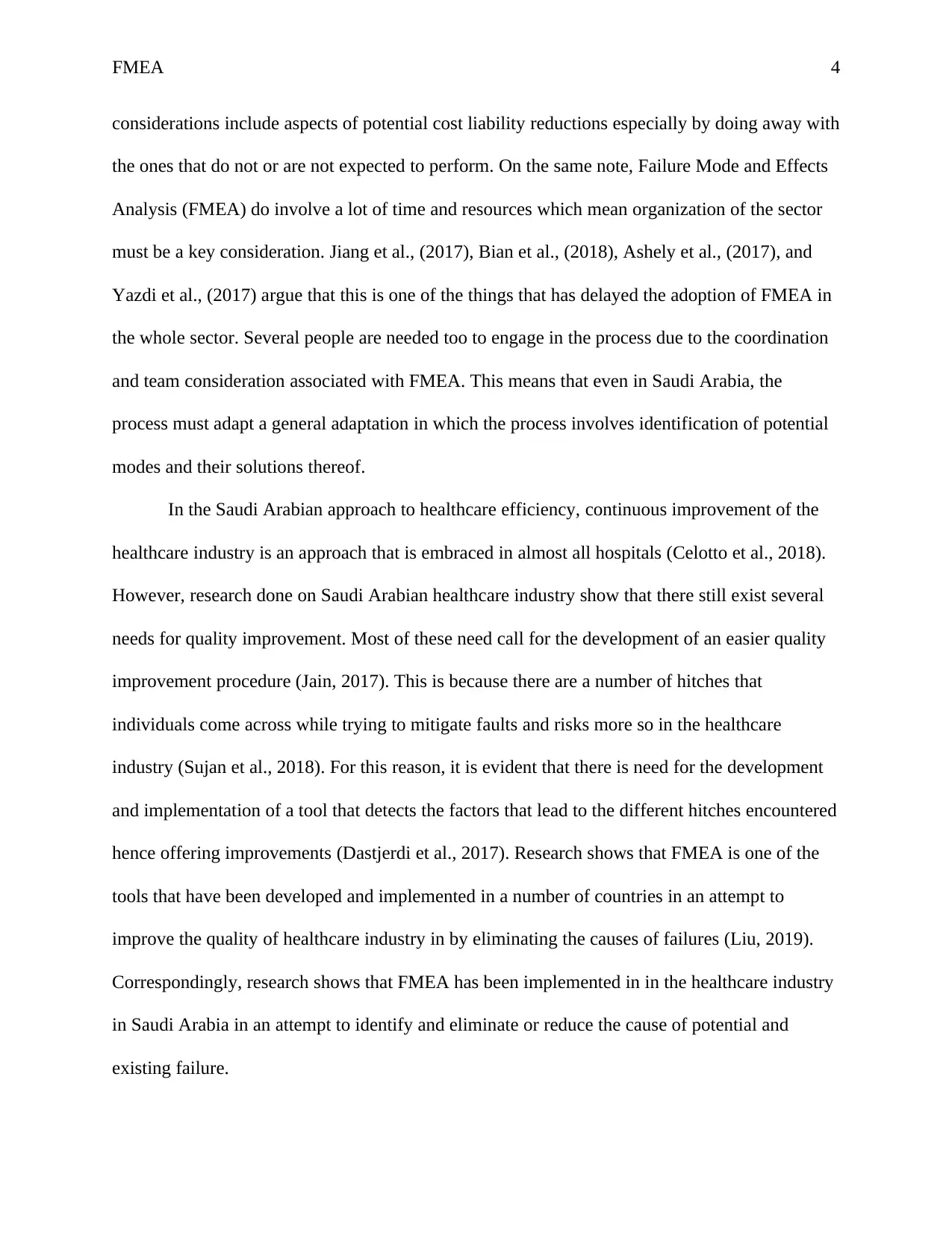
FMEA 4
considerations include aspects of potential cost liability reductions especially by doing away with
the ones that do not or are not expected to perform. On the same note, Failure Mode and Effects
Analysis (FMEA) do involve a lot of time and resources which mean organization of the sector
must be a key consideration. Jiang et al., (2017), Bian et al., (2018), Ashely et al., (2017), and
Yazdi et al., (2017) argue that this is one of the things that has delayed the adoption of FMEA in
the whole sector. Several people are needed too to engage in the process due to the coordination
and team consideration associated with FMEA. This means that even in Saudi Arabia, the
process must adapt a general adaptation in which the process involves identification of potential
modes and their solutions thereof.
In the Saudi Arabian approach to healthcare efficiency, continuous improvement of the
healthcare industry is an approach that is embraced in almost all hospitals (Celotto et al., 2018).
However, research done on Saudi Arabian healthcare industry show that there still exist several
needs for quality improvement. Most of these need call for the development of an easier quality
improvement procedure (Jain, 2017). This is because there are a number of hitches that
individuals come across while trying to mitigate faults and risks more so in the healthcare
industry (Sujan et al., 2018). For this reason, it is evident that there is need for the development
and implementation of a tool that detects the factors that lead to the different hitches encountered
hence offering improvements (Dastjerdi et al., 2017). Research shows that FMEA is one of the
tools that have been developed and implemented in a number of countries in an attempt to
improve the quality of healthcare industry in by eliminating the causes of failures (Liu, 2019).
Correspondingly, research shows that FMEA has been implemented in in the healthcare industry
in Saudi Arabia in an attempt to identify and eliminate or reduce the cause of potential and
existing failure.
considerations include aspects of potential cost liability reductions especially by doing away with
the ones that do not or are not expected to perform. On the same note, Failure Mode and Effects
Analysis (FMEA) do involve a lot of time and resources which mean organization of the sector
must be a key consideration. Jiang et al., (2017), Bian et al., (2018), Ashely et al., (2017), and
Yazdi et al., (2017) argue that this is one of the things that has delayed the adoption of FMEA in
the whole sector. Several people are needed too to engage in the process due to the coordination
and team consideration associated with FMEA. This means that even in Saudi Arabia, the
process must adapt a general adaptation in which the process involves identification of potential
modes and their solutions thereof.
In the Saudi Arabian approach to healthcare efficiency, continuous improvement of the
healthcare industry is an approach that is embraced in almost all hospitals (Celotto et al., 2018).
However, research done on Saudi Arabian healthcare industry show that there still exist several
needs for quality improvement. Most of these need call for the development of an easier quality
improvement procedure (Jain, 2017). This is because there are a number of hitches that
individuals come across while trying to mitigate faults and risks more so in the healthcare
industry (Sujan et al., 2018). For this reason, it is evident that there is need for the development
and implementation of a tool that detects the factors that lead to the different hitches encountered
hence offering improvements (Dastjerdi et al., 2017). Research shows that FMEA is one of the
tools that have been developed and implemented in a number of countries in an attempt to
improve the quality of healthcare industry in by eliminating the causes of failures (Liu, 2019).
Correspondingly, research shows that FMEA has been implemented in in the healthcare industry
in Saudi Arabia in an attempt to identify and eliminate or reduce the cause of potential and
existing failure.
Paraphrase This Document
Need a fresh take? Get an instant paraphrase of this document with our AI Paraphraser
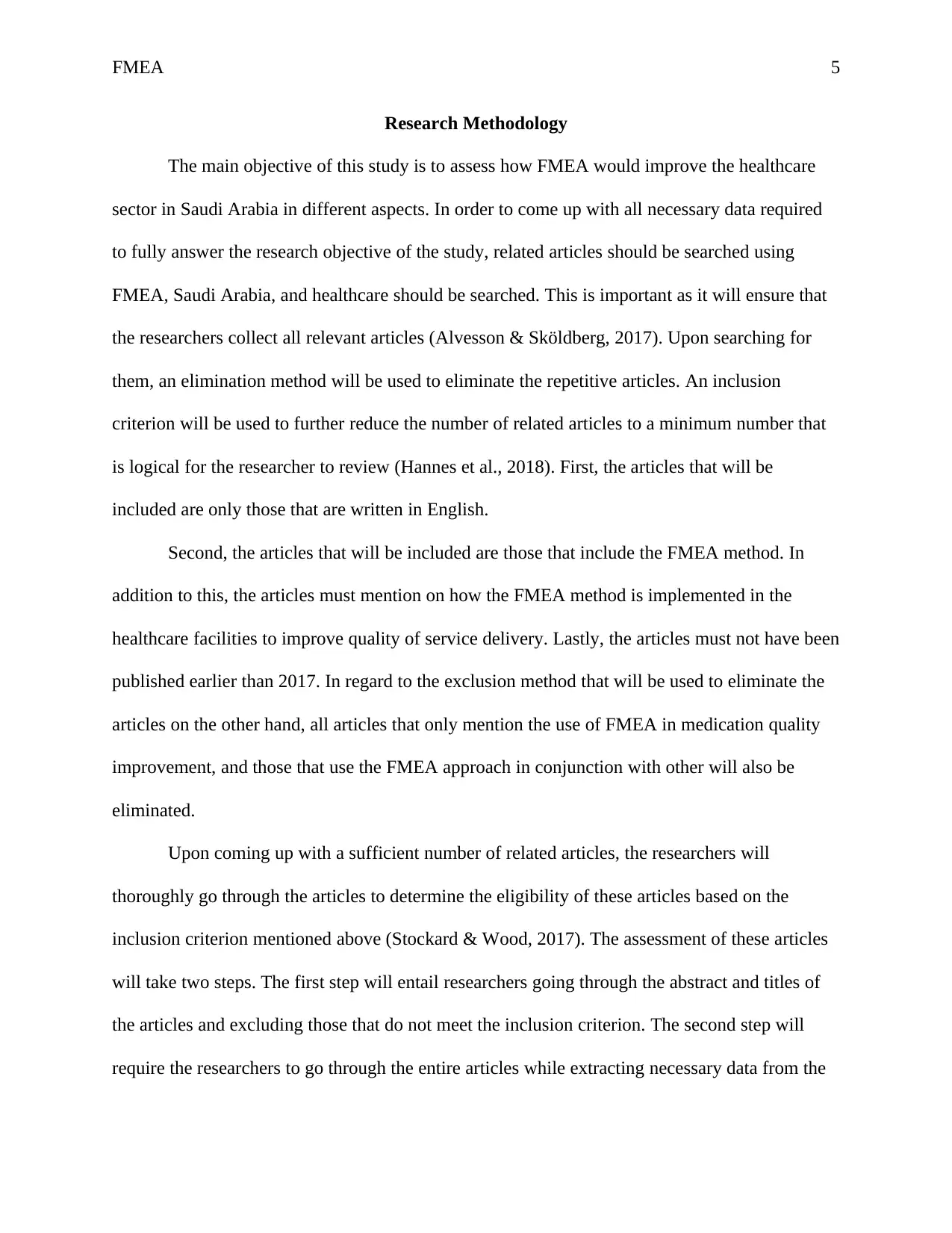
FMEA 5
Research Methodology
The main objective of this study is to assess how FMEA would improve the healthcare
sector in Saudi Arabia in different aspects. In order to come up with all necessary data required
to fully answer the research objective of the study, related articles should be searched using
FMEA, Saudi Arabia, and healthcare should be searched. This is important as it will ensure that
the researchers collect all relevant articles (Alvesson & Sköldberg, 2017). Upon searching for
them, an elimination method will be used to eliminate the repetitive articles. An inclusion
criterion will be used to further reduce the number of related articles to a minimum number that
is logical for the researcher to review (Hannes et al., 2018). First, the articles that will be
included are only those that are written in English.
Second, the articles that will be included are those that include the FMEA method. In
addition to this, the articles must mention on how the FMEA method is implemented in the
healthcare facilities to improve quality of service delivery. Lastly, the articles must not have been
published earlier than 2017. In regard to the exclusion method that will be used to eliminate the
articles on the other hand, all articles that only mention the use of FMEA in medication quality
improvement, and those that use the FMEA approach in conjunction with other will also be
eliminated.
Upon coming up with a sufficient number of related articles, the researchers will
thoroughly go through the articles to determine the eligibility of these articles based on the
inclusion criterion mentioned above (Stockard & Wood, 2017). The assessment of these articles
will take two steps. The first step will entail researchers going through the abstract and titles of
the articles and excluding those that do not meet the inclusion criterion. The second step will
require the researchers to go through the entire articles while extracting necessary data from the
Research Methodology
The main objective of this study is to assess how FMEA would improve the healthcare
sector in Saudi Arabia in different aspects. In order to come up with all necessary data required
to fully answer the research objective of the study, related articles should be searched using
FMEA, Saudi Arabia, and healthcare should be searched. This is important as it will ensure that
the researchers collect all relevant articles (Alvesson & Sköldberg, 2017). Upon searching for
them, an elimination method will be used to eliminate the repetitive articles. An inclusion
criterion will be used to further reduce the number of related articles to a minimum number that
is logical for the researcher to review (Hannes et al., 2018). First, the articles that will be
included are only those that are written in English.
Second, the articles that will be included are those that include the FMEA method. In
addition to this, the articles must mention on how the FMEA method is implemented in the
healthcare facilities to improve quality of service delivery. Lastly, the articles must not have been
published earlier than 2017. In regard to the exclusion method that will be used to eliminate the
articles on the other hand, all articles that only mention the use of FMEA in medication quality
improvement, and those that use the FMEA approach in conjunction with other will also be
eliminated.
Upon coming up with a sufficient number of related articles, the researchers will
thoroughly go through the articles to determine the eligibility of these articles based on the
inclusion criterion mentioned above (Stockard & Wood, 2017). The assessment of these articles
will take two steps. The first step will entail researchers going through the abstract and titles of
the articles and excluding those that do not meet the inclusion criterion. The second step will
require the researchers to go through the entire articles while extracting necessary data from the
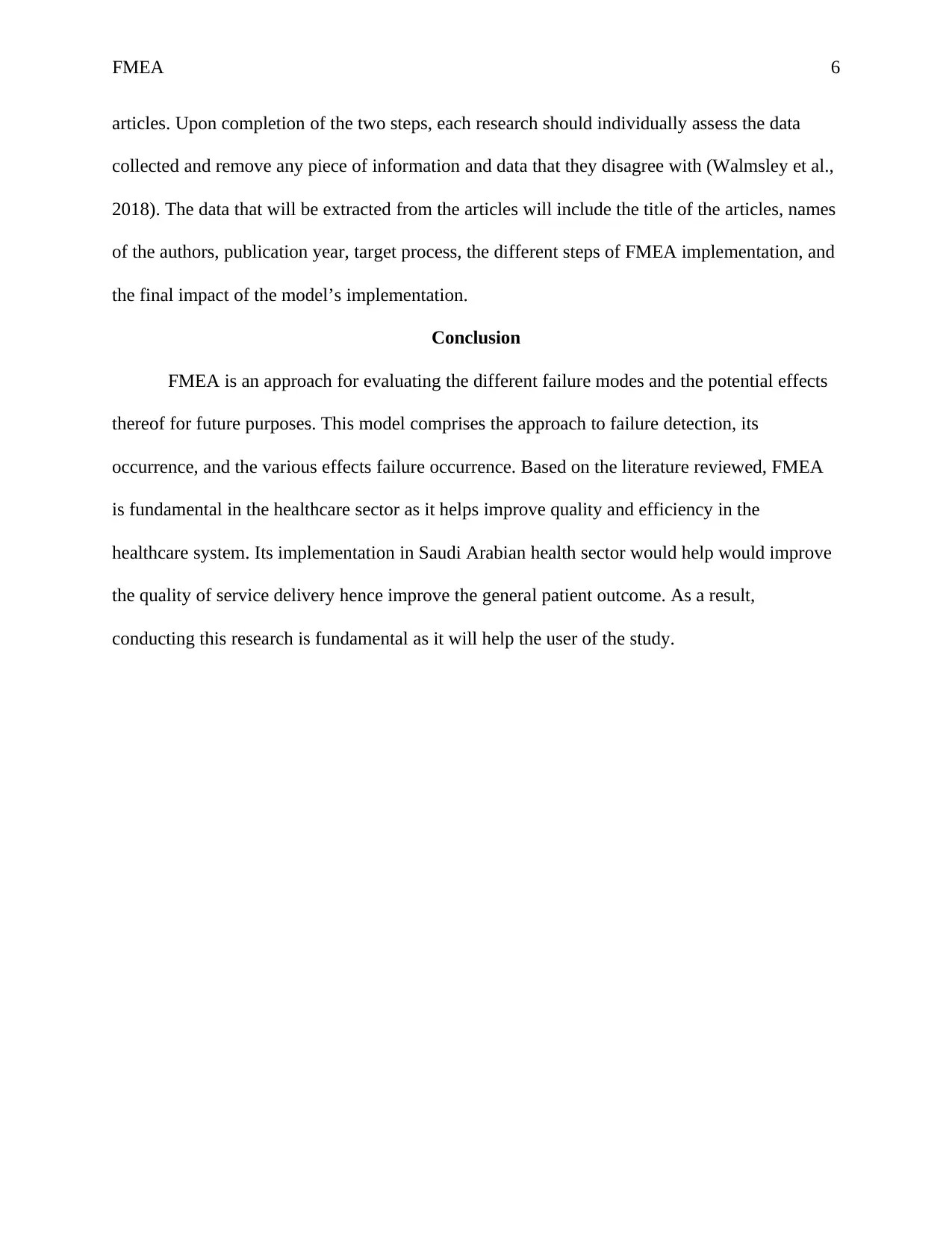
FMEA 6
articles. Upon completion of the two steps, each research should individually assess the data
collected and remove any piece of information and data that they disagree with (Walmsley et al.,
2018). The data that will be extracted from the articles will include the title of the articles, names
of the authors, publication year, target process, the different steps of FMEA implementation, and
the final impact of the model’s implementation.
Conclusion
FMEA is an approach for evaluating the different failure modes and the potential effects
thereof for future purposes. This model comprises the approach to failure detection, its
occurrence, and the various effects failure occurrence. Based on the literature reviewed, FMEA
is fundamental in the healthcare sector as it helps improve quality and efficiency in the
healthcare system. Its implementation in Saudi Arabian health sector would help would improve
the quality of service delivery hence improve the general patient outcome. As a result,
conducting this research is fundamental as it will help the user of the study.
articles. Upon completion of the two steps, each research should individually assess the data
collected and remove any piece of information and data that they disagree with (Walmsley et al.,
2018). The data that will be extracted from the articles will include the title of the articles, names
of the authors, publication year, target process, the different steps of FMEA implementation, and
the final impact of the model’s implementation.
Conclusion
FMEA is an approach for evaluating the different failure modes and the potential effects
thereof for future purposes. This model comprises the approach to failure detection, its
occurrence, and the various effects failure occurrence. Based on the literature reviewed, FMEA
is fundamental in the healthcare sector as it helps improve quality and efficiency in the
healthcare system. Its implementation in Saudi Arabian health sector would help would improve
the quality of service delivery hence improve the general patient outcome. As a result,
conducting this research is fundamental as it will help the user of the study.
⊘ This is a preview!⊘
Do you want full access?
Subscribe today to unlock all pages.

Trusted by 1+ million students worldwide
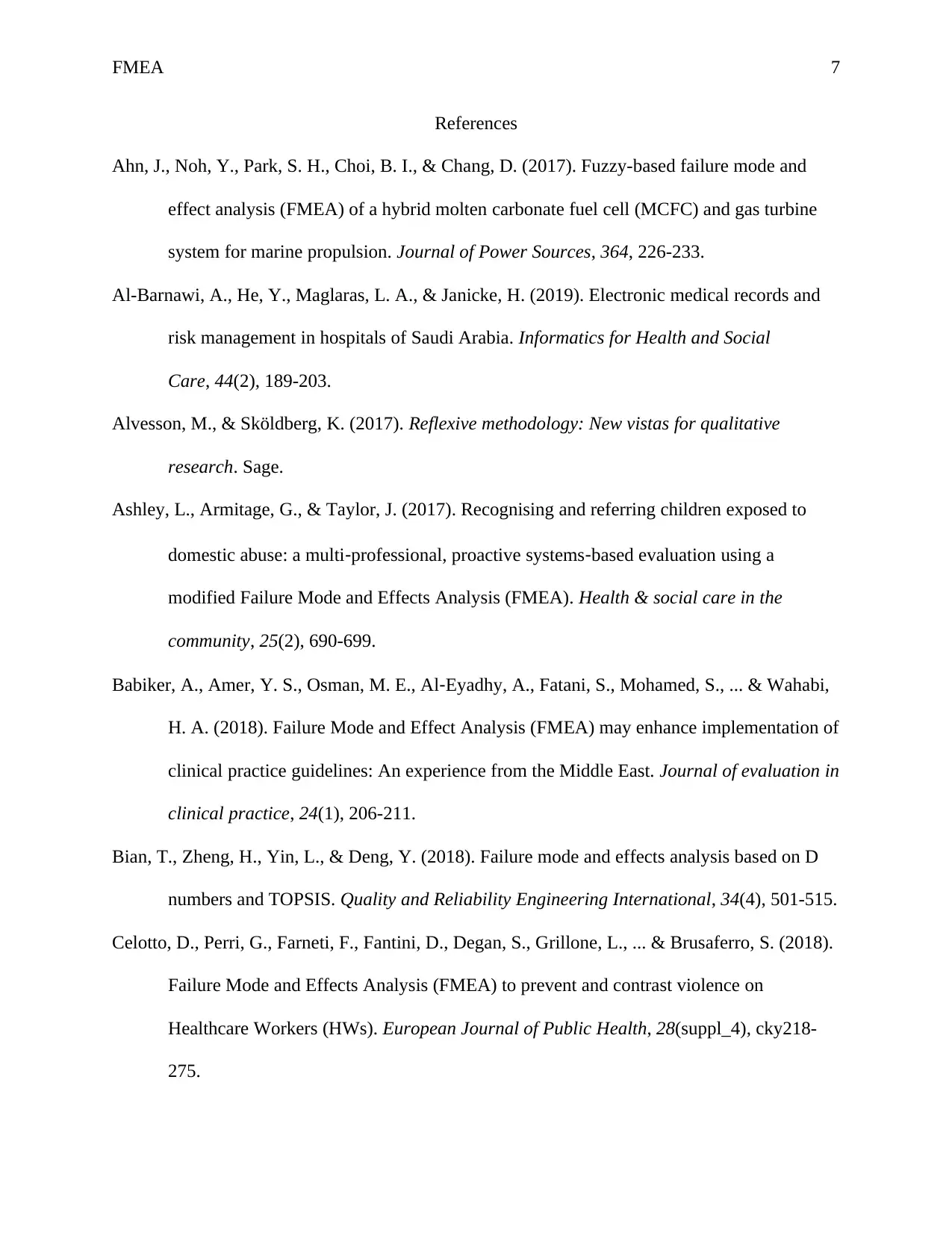
FMEA 7
References
Ahn, J., Noh, Y., Park, S. H., Choi, B. I., & Chang, D. (2017). Fuzzy-based failure mode and
effect analysis (FMEA) of a hybrid molten carbonate fuel cell (MCFC) and gas turbine
system for marine propulsion. Journal of Power Sources, 364, 226-233.
Al-Barnawi, A., He, Y., Maglaras, L. A., & Janicke, H. (2019). Electronic medical records and
risk management in hospitals of Saudi Arabia. Informatics for Health and Social
Care, 44(2), 189-203.
Alvesson, M., & Sköldberg, K. (2017). Reflexive methodology: New vistas for qualitative
research. Sage.
Ashley, L., Armitage, G., & Taylor, J. (2017). Recognising and referring children exposed to
domestic abuse: a multi‐professional, proactive systems‐based evaluation using a
modified Failure Mode and Effects Analysis (FMEA). Health & social care in the
community, 25(2), 690-699.
Babiker, A., Amer, Y. S., Osman, M. E., Al‐Eyadhy, A., Fatani, S., Mohamed, S., ... & Wahabi,
H. A. (2018). Failure Mode and Effect Analysis (FMEA) may enhance implementation of
clinical practice guidelines: An experience from the Middle East. Journal of evaluation in
clinical practice, 24(1), 206-211.
Bian, T., Zheng, H., Yin, L., & Deng, Y. (2018). Failure mode and effects analysis based on D
numbers and TOPSIS. Quality and Reliability Engineering International, 34(4), 501-515.
Celotto, D., Perri, G., Farneti, F., Fantini, D., Degan, S., Grillone, L., ... & Brusaferro, S. (2018).
Failure Mode and Effects Analysis (FMEA) to prevent and contrast violence on
Healthcare Workers (HWs). European Journal of Public Health, 28(suppl_4), cky218-
275.
References
Ahn, J., Noh, Y., Park, S. H., Choi, B. I., & Chang, D. (2017). Fuzzy-based failure mode and
effect analysis (FMEA) of a hybrid molten carbonate fuel cell (MCFC) and gas turbine
system for marine propulsion. Journal of Power Sources, 364, 226-233.
Al-Barnawi, A., He, Y., Maglaras, L. A., & Janicke, H. (2019). Electronic medical records and
risk management in hospitals of Saudi Arabia. Informatics for Health and Social
Care, 44(2), 189-203.
Alvesson, M., & Sköldberg, K. (2017). Reflexive methodology: New vistas for qualitative
research. Sage.
Ashley, L., Armitage, G., & Taylor, J. (2017). Recognising and referring children exposed to
domestic abuse: a multi‐professional, proactive systems‐based evaluation using a
modified Failure Mode and Effects Analysis (FMEA). Health & social care in the
community, 25(2), 690-699.
Babiker, A., Amer, Y. S., Osman, M. E., Al‐Eyadhy, A., Fatani, S., Mohamed, S., ... & Wahabi,
H. A. (2018). Failure Mode and Effect Analysis (FMEA) may enhance implementation of
clinical practice guidelines: An experience from the Middle East. Journal of evaluation in
clinical practice, 24(1), 206-211.
Bian, T., Zheng, H., Yin, L., & Deng, Y. (2018). Failure mode and effects analysis based on D
numbers and TOPSIS. Quality and Reliability Engineering International, 34(4), 501-515.
Celotto, D., Perri, G., Farneti, F., Fantini, D., Degan, S., Grillone, L., ... & Brusaferro, S. (2018).
Failure Mode and Effects Analysis (FMEA) to prevent and contrast violence on
Healthcare Workers (HWs). European Journal of Public Health, 28(suppl_4), cky218-
275.
Paraphrase This Document
Need a fresh take? Get an instant paraphrase of this document with our AI Paraphraser
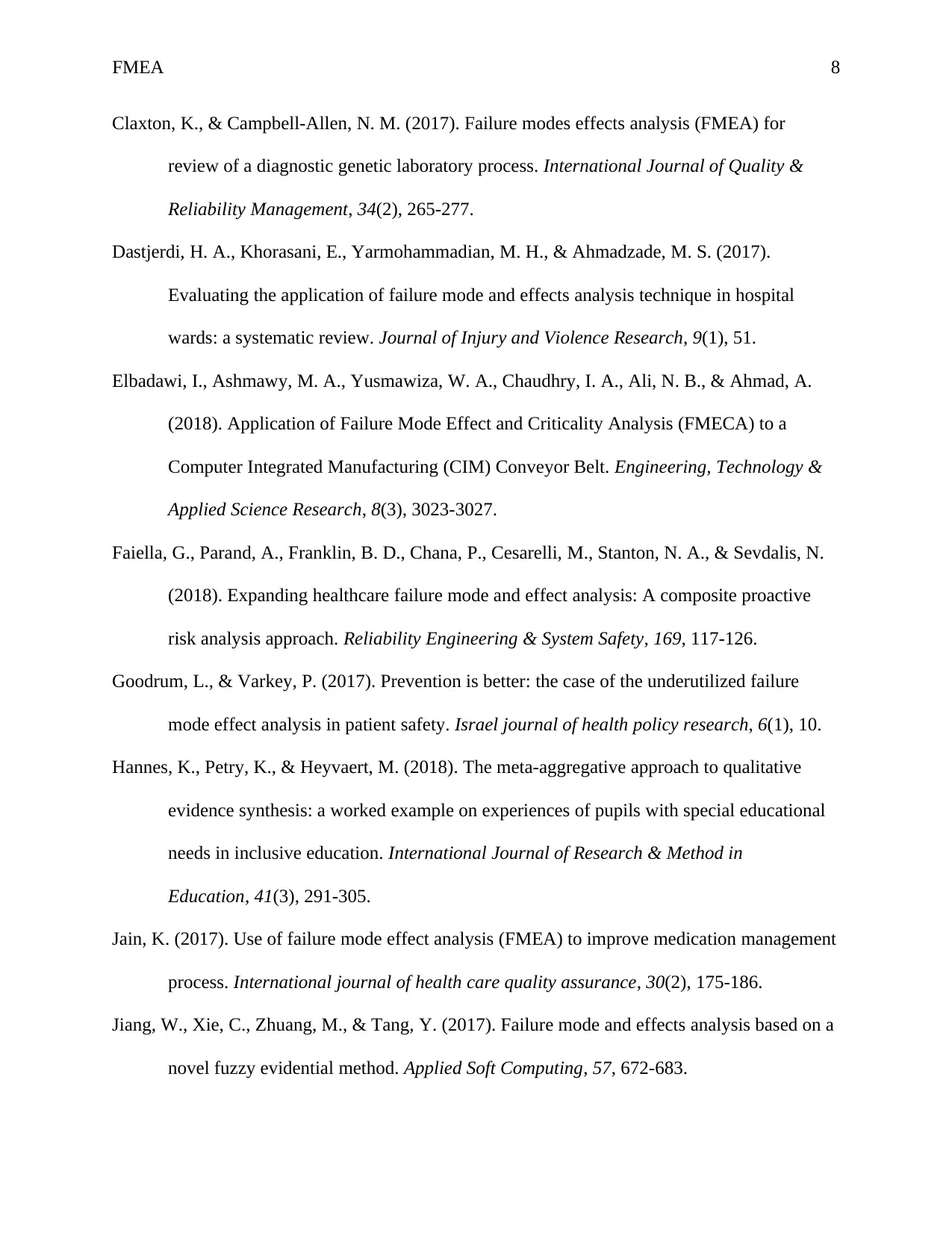
FMEA 8
Claxton, K., & Campbell-Allen, N. M. (2017). Failure modes effects analysis (FMEA) for
review of a diagnostic genetic laboratory process. International Journal of Quality &
Reliability Management, 34(2), 265-277.
Dastjerdi, H. A., Khorasani, E., Yarmohammadian, M. H., & Ahmadzade, M. S. (2017).
Evaluating the application of failure mode and effects analysis technique in hospital
wards: a systematic review. Journal of Injury and Violence Research, 9(1), 51.
Elbadawi, I., Ashmawy, M. A., Yusmawiza, W. A., Chaudhry, I. A., Ali, N. B., & Ahmad, A.
(2018). Application of Failure Mode Effect and Criticality Analysis (FMECA) to a
Computer Integrated Manufacturing (CIM) Conveyor Belt. Engineering, Technology &
Applied Science Research, 8(3), 3023-3027.
Faiella, G., Parand, A., Franklin, B. D., Chana, P., Cesarelli, M., Stanton, N. A., & Sevdalis, N.
(2018). Expanding healthcare failure mode and effect analysis: A composite proactive
risk analysis approach. Reliability Engineering & System Safety, 169, 117-126.
Goodrum, L., & Varkey, P. (2017). Prevention is better: the case of the underutilized failure
mode effect analysis in patient safety. Israel journal of health policy research, 6(1), 10.
Hannes, K., Petry, K., & Heyvaert, M. (2018). The meta-aggregative approach to qualitative
evidence synthesis: a worked example on experiences of pupils with special educational
needs in inclusive education. International Journal of Research & Method in
Education, 41(3), 291-305.
Jain, K. (2017). Use of failure mode effect analysis (FMEA) to improve medication management
process. International journal of health care quality assurance, 30(2), 175-186.
Jiang, W., Xie, C., Zhuang, M., & Tang, Y. (2017). Failure mode and effects analysis based on a
novel fuzzy evidential method. Applied Soft Computing, 57, 672-683.
Claxton, K., & Campbell-Allen, N. M. (2017). Failure modes effects analysis (FMEA) for
review of a diagnostic genetic laboratory process. International Journal of Quality &
Reliability Management, 34(2), 265-277.
Dastjerdi, H. A., Khorasani, E., Yarmohammadian, M. H., & Ahmadzade, M. S. (2017).
Evaluating the application of failure mode and effects analysis technique in hospital
wards: a systematic review. Journal of Injury and Violence Research, 9(1), 51.
Elbadawi, I., Ashmawy, M. A., Yusmawiza, W. A., Chaudhry, I. A., Ali, N. B., & Ahmad, A.
(2018). Application of Failure Mode Effect and Criticality Analysis (FMECA) to a
Computer Integrated Manufacturing (CIM) Conveyor Belt. Engineering, Technology &
Applied Science Research, 8(3), 3023-3027.
Faiella, G., Parand, A., Franklin, B. D., Chana, P., Cesarelli, M., Stanton, N. A., & Sevdalis, N.
(2018). Expanding healthcare failure mode and effect analysis: A composite proactive
risk analysis approach. Reliability Engineering & System Safety, 169, 117-126.
Goodrum, L., & Varkey, P. (2017). Prevention is better: the case of the underutilized failure
mode effect analysis in patient safety. Israel journal of health policy research, 6(1), 10.
Hannes, K., Petry, K., & Heyvaert, M. (2018). The meta-aggregative approach to qualitative
evidence synthesis: a worked example on experiences of pupils with special educational
needs in inclusive education. International Journal of Research & Method in
Education, 41(3), 291-305.
Jain, K. (2017). Use of failure mode effect analysis (FMEA) to improve medication management
process. International journal of health care quality assurance, 30(2), 175-186.
Jiang, W., Xie, C., Zhuang, M., & Tang, Y. (2017). Failure mode and effects analysis based on a
novel fuzzy evidential method. Applied Soft Computing, 57, 672-683.

FMEA 9
Kumar, A., & Chaterjee, S. (2017). Outbreak of Middle East respiratory syndrome coronavirus,
Saudi Arabian experience. Current Medicine Research and Practice, 7(4), 132-134.
Liu, H. C. (2019). FMEA for Proactive Healthcare Risk Analysis: A Systematic Literature
Review. In Improved FMEA Methods for Proactive Healthcare Risk Analysis (pp. 15-45).
Springer, Singapore.
Niv, Y., Itskoviz, D., Cohen, M., Hendel, H., Bar-Giora, Y., Berkov, E., ... & Ganor, A. (2018).
The utility of failure modes and effects analysis of consultations in a tertiary, academic,
medical center. Quality management in health care, 27(2), 69-73.
Stockard, J., & Wood, T. W. (2017). The Threshold and Inclusive Approaches to Determining
“Best Available Evidence” An Empirical Analysis. American Journal of
Evaluation, 38(4), 471-492.
Sujan, M. A., Embrey, D., & Huang, H. (2018). On the application of human reliability analysis
in healthcare: opportunities and challenges. Reliability Engineering & System Safety.
Walmsley, J., Strnadová, I., & Johnson, K. (2018). The added value of inclusive
research. Journal of Applied Research in Intellectual Disabilities, 31(5), 751-759.
Xu, A. Y., Bhatnagar, J., Bednarz, G., Flickinger, J., Arai, Y., Vacsulka, J., ... & Huq, M. S.
(2017). Failure modes and effects analysis (FMEA) for Gamma knife
radiosurgery. Journal of applied clinical medical physics, 18(6), 152-168.
Xu, Z., Lee, S., Albani, D., Dobbins, D., Ellis, R. J., Biswas, T., ... & Podder, T. K. (2019).
Evaluating radiotherapy treatment delay using Failure Mode and Effects Analysis
(FMEA). Radiotherapy and Oncology, 137, 102-109.
Kumar, A., & Chaterjee, S. (2017). Outbreak of Middle East respiratory syndrome coronavirus,
Saudi Arabian experience. Current Medicine Research and Practice, 7(4), 132-134.
Liu, H. C. (2019). FMEA for Proactive Healthcare Risk Analysis: A Systematic Literature
Review. In Improved FMEA Methods for Proactive Healthcare Risk Analysis (pp. 15-45).
Springer, Singapore.
Niv, Y., Itskoviz, D., Cohen, M., Hendel, H., Bar-Giora, Y., Berkov, E., ... & Ganor, A. (2018).
The utility of failure modes and effects analysis of consultations in a tertiary, academic,
medical center. Quality management in health care, 27(2), 69-73.
Stockard, J., & Wood, T. W. (2017). The Threshold and Inclusive Approaches to Determining
“Best Available Evidence” An Empirical Analysis. American Journal of
Evaluation, 38(4), 471-492.
Sujan, M. A., Embrey, D., & Huang, H. (2018). On the application of human reliability analysis
in healthcare: opportunities and challenges. Reliability Engineering & System Safety.
Walmsley, J., Strnadová, I., & Johnson, K. (2018). The added value of inclusive
research. Journal of Applied Research in Intellectual Disabilities, 31(5), 751-759.
Xu, A. Y., Bhatnagar, J., Bednarz, G., Flickinger, J., Arai, Y., Vacsulka, J., ... & Huq, M. S.
(2017). Failure modes and effects analysis (FMEA) for Gamma knife
radiosurgery. Journal of applied clinical medical physics, 18(6), 152-168.
Xu, Z., Lee, S., Albani, D., Dobbins, D., Ellis, R. J., Biswas, T., ... & Podder, T. K. (2019).
Evaluating radiotherapy treatment delay using Failure Mode and Effects Analysis
(FMEA). Radiotherapy and Oncology, 137, 102-109.
⊘ This is a preview!⊘
Do you want full access?
Subscribe today to unlock all pages.

Trusted by 1+ million students worldwide
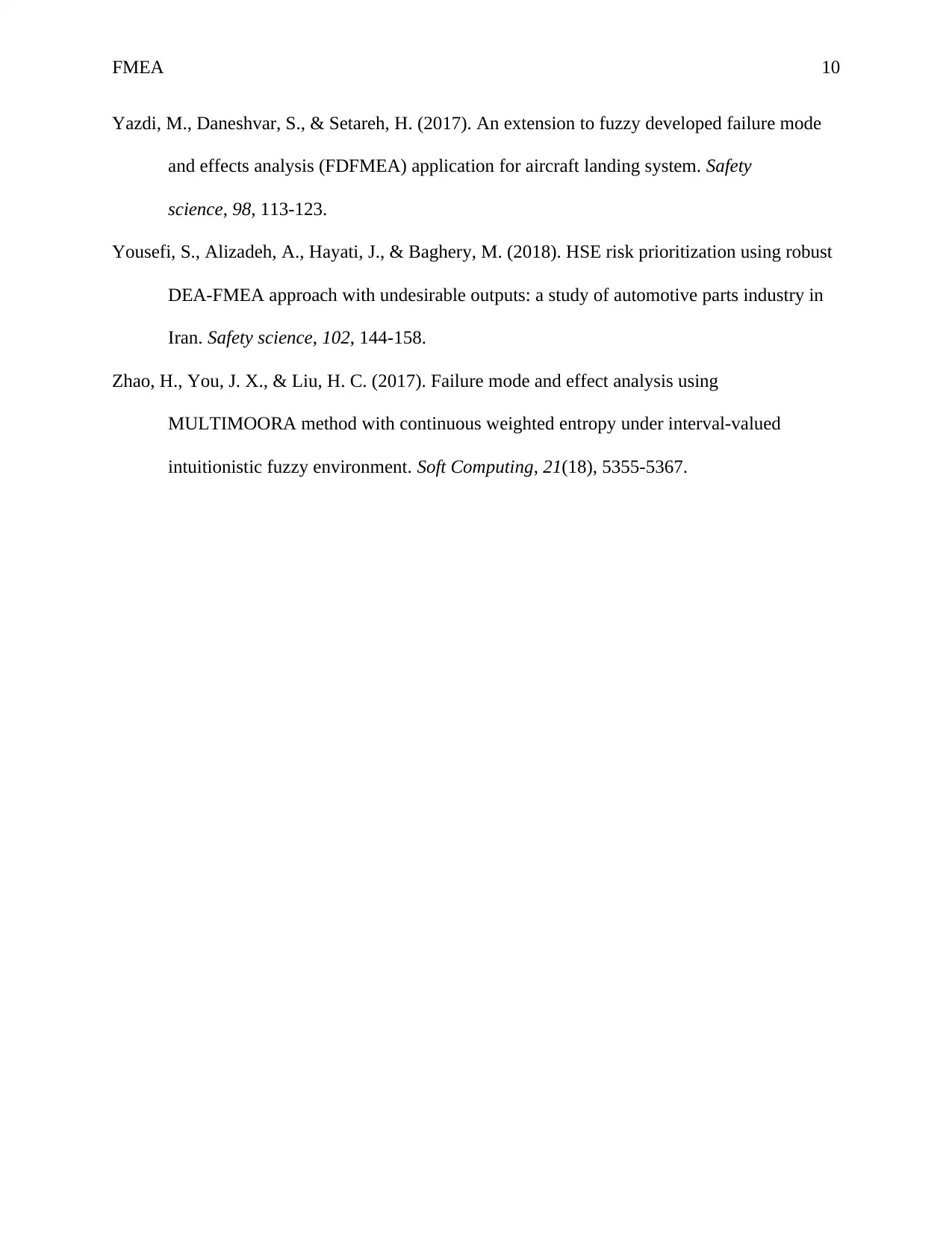
FMEA 10
Yazdi, M., Daneshvar, S., & Setareh, H. (2017). An extension to fuzzy developed failure mode
and effects analysis (FDFMEA) application for aircraft landing system. Safety
science, 98, 113-123.
Yousefi, S., Alizadeh, A., Hayati, J., & Baghery, M. (2018). HSE risk prioritization using robust
DEA-FMEA approach with undesirable outputs: a study of automotive parts industry in
Iran. Safety science, 102, 144-158.
Zhao, H., You, J. X., & Liu, H. C. (2017). Failure mode and effect analysis using
MULTIMOORA method with continuous weighted entropy under interval-valued
intuitionistic fuzzy environment. Soft Computing, 21(18), 5355-5367.
Yazdi, M., Daneshvar, S., & Setareh, H. (2017). An extension to fuzzy developed failure mode
and effects analysis (FDFMEA) application for aircraft landing system. Safety
science, 98, 113-123.
Yousefi, S., Alizadeh, A., Hayati, J., & Baghery, M. (2018). HSE risk prioritization using robust
DEA-FMEA approach with undesirable outputs: a study of automotive parts industry in
Iran. Safety science, 102, 144-158.
Zhao, H., You, J. X., & Liu, H. C. (2017). Failure mode and effect analysis using
MULTIMOORA method with continuous weighted entropy under interval-valued
intuitionistic fuzzy environment. Soft Computing, 21(18), 5355-5367.
1 out of 10
Related Documents
Your All-in-One AI-Powered Toolkit for Academic Success.
+13062052269
info@desklib.com
Available 24*7 on WhatsApp / Email
![[object Object]](/_next/static/media/star-bottom.7253800d.svg)
Unlock your academic potential
Copyright © 2020–2025 A2Z Services. All Rights Reserved. Developed and managed by ZUCOL.





